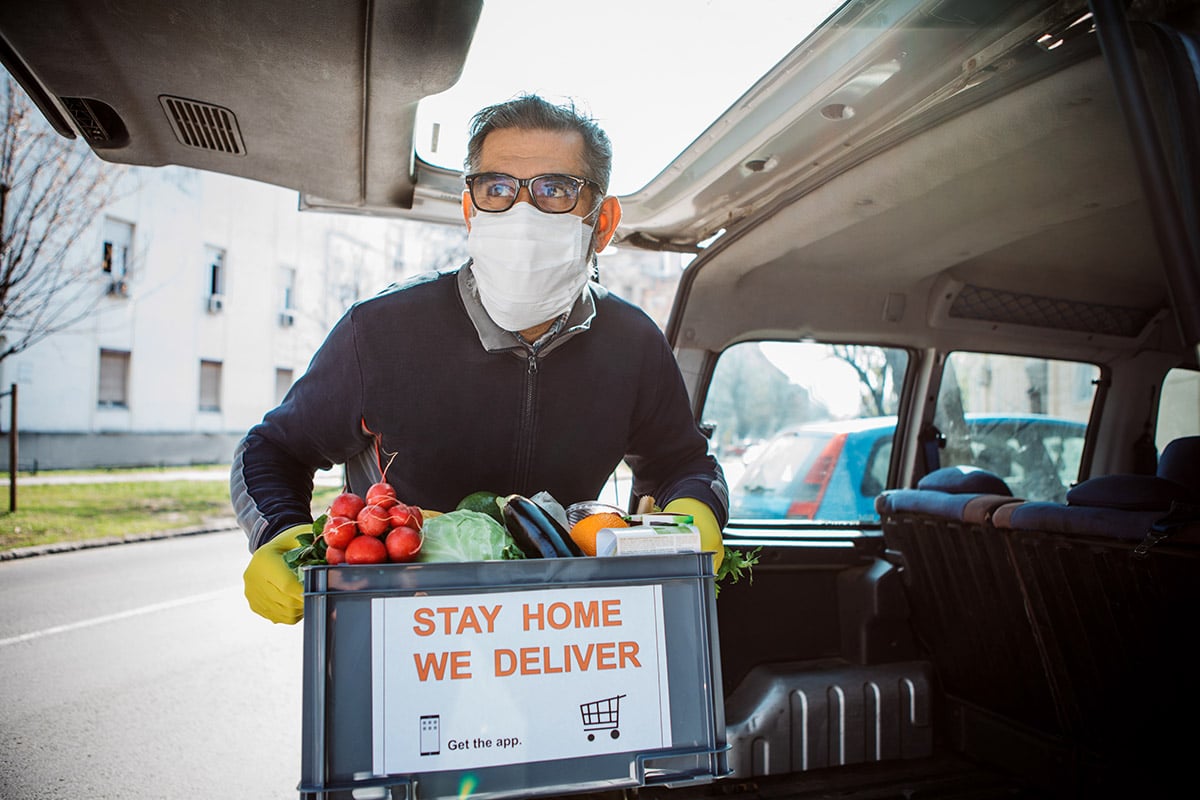Rideshare vs. Delivery Jobs? The Good, the Bad and the Ugly

While downloading the DoorDash or Uber app is simple enough, there aren’t many clear resources for gig workers when it comes to figuring out earning potential.
Sure, there are stories of people raking it in, like this Uber driver who documented on TikTok how he made $8,000 a month. How much you make depends on where you live (state plus big city or little city) and how much and what hours you work.
With such a limited amount of available info, and a huge variability between different cities and marketplaces, we thought it was time to call in the experts to talk about rideshare vs. delivery jobs.
Whether you’re brand new to rideshare and delivery driving, trying to make the switch from one the other, or just hoping to max out your earnings— we’ve crafted this list of pros and cons just for you. Here’s everything you need to know to up your game as a delivery or rideshare driver.
Driver Salaries, in General
After chatting with rideshare and delivery drivers from all over the country — a few things stood out. The first, is that there aren’t many hard and fast rules when it comes to how much a driver can earn in an hour or even a day.
The second is that longer rideshare drives can sometimes yield more profit than shorter trips— whether they be for rideshare or delivery driving.
“In my market of St. Louis, a typical airport trip will earn on average $25,” says expert driver and gig-tuber Pedro Santiago. “It would take roughly two to three deliveries to earn the same.”
According to indeed.com, the national average for Uber drivers is about $33,000 a year. But as you will see from this story, some drivers experience just the opposite: rideshare drivers make more than delivery drivers.
Something to keep in mind is that variables such as where you drive, when you drive, and even what’s happening in the economy (like a global pandemic), all have a part to play in how much drivers make.
That’s why we chose to focus on the pros and cons of each driving gig separately. Depending on where you live and how you like to work, these tips from experienced drivers should help inform your own work decisions and maximize your earning potential.
Pros & Cons of Delivery Driving
There are a number of pros and cons to consider when it comes to groceries or food delivery gigs. Here are the main ones, as highlighted by our experts.
Pros of Delivery
If you prefer driving alone without passengers, then you might just like delivery driving. This includes delivering grocery and takeout orders, as well as other types of deliveries from point A to B.
Personal Safety
One of the most obvious pros when it comes to making deliveries rather than rideshare driving is safety. “Even as the COVID vaccines roll out, many gig drivers still feel safer carrying packages than people,” says Heather Hughes of crowdsourced delivery platform Roadie.
Beyond the risk of getting sick, there’s also general safety matters to consider. For example, you may feel safer driving at night if you were making deliveries, rather than having a stranger in your car.
Avoid Vehicle Wear & Tear
Another aspect of delivery that’s worth considering is that it involves significantly less wear and tear on your vehicle. The reasoning behind this is two-fold: While you don’t have people making a mess in your car, you’re also less likely to drive long distances. This can save you money on gas, routine inspections, and more.
“When doing deliveries, you’ll often have shorter driving distances,” says Harry Campbell, former rideshare driver and founder of The Rideshare Guy, a media platform for all things rideshare. “Delivery companies actually don’t want you going very far because then the food gets cold!”
More Flexibility
While the term flexibility is relative, there’s undoubtedly a bit more wiggle room regarding formalities with delivery driving. For starters, you don’t have to make deliveries alone. “For delivery driving, a major pro is being able to ‘pair deliver,’ i.e. deliver with someone else,” says Campbell. “This is great for people who have to bring kids along.”
You also aren’t required to drive late at night if you don’t want to.
“For the most part, the busiest times for delivery drivers are during lunch and dinner hours,” says Campbell.
Cons of Delivery
Just because you’re transporting food instead of people doesn’t mean the job is easy (or perfect). Here are some of the biggest cons associated with delivery driving.
Time Pressure
Traffic happens, and while living, breathing passengers might understand this — those receiving cold food may not. There’s a definite correlation between the condition food arrives in and how happy your customers are, even if the food being bad or cold isn’t your fault.
“Cons for delivery driving include having no control over how the food will come out, and occasionally having to ‘batch’ orders,” says Campbell. “Batch orders happen when the company sends you to make two separate deliveries at the same time. Usually the food in the second delivery is a little soggier — and the customer is a little grumpier because it took longer!”
But delivery drivers aren’t just responsible for delivering hot food in a timely manner. They also get all sorts of pressure from restaurants to pick up food quickly.
“When a delivery offer is accepted by the driver, they need to pick it up in a timely manner, otherwise they’ll receive an alert asking if they still want to make the delivery,” says Santiago. “All of this time they spend getting to the restaurant is monitored by gps movement.”
Delivery Can be Less Lucrative
The drivers we spoke to agreed that you tend to earn less as a delivery driver than a rideshare driver.
“If you only look at pure hourly earnings paid by platforms, you would typically earn more ridesharing than delivering food or groceries,” says Eleonora Patricola of Best Referral Driver.
Campbell, the Rideshare Guy founder, describes a typical Uber hourly wage as $15 – $20 per hour, while Hughes says Roadie drivers typically earn around $13 per local delivery. Delivery drivers can, though, accept multiple deliveries that are going in the same direction at once, making the most of their time on the road and earning more money per mile.
These numbers are different from what Indeed.com lists and that speaks to the many variables (location and hours worked) in pay.
Parking
Although you may not have any passengers to deal with, that doesn’t mean delivery driving is without its challenges — like trying to find a place to park your car while you make deliveries on a busy street during rush hour.
“If you plan to deliver food in large cities, parking might become your worst nightmare,” says Patricola.
Pros & Cons of Rideshare Driving
The pandemic might have temporarily disabled rideshare driving, but the experts we spoke to assured us the market is back in full swing. These hacks can even help you make more money as an Uber driver.
“With the rise of people going back to offices, traveling becoming more common, restaurants opening dining rooms, and covid restrictions being lifted it’s given the public more confidence to go out again,” says expert driver and gig-tuber Santiago.
With increasingly high demand, and not enough drivers to meet it, many drivers are even earning higher fares than they did before the pandemic. Here are some pros and cons to consider before you dive in as a rideshare driver.
Pros of Rideshare
Unlike delivery driving, rideshare driving involves transporting people (rather than food or things) from one place to another.
More Money, Maybe
Probably the biggest plus when it comes to rideshare driving is the money. And although it’s a relatively small difference in pay between delivery and rideshare driving, most experts thought it worth mentioning all the same.
“Rideshare demand is rebounding, and the incentives are higher than ever,” says Los Angeles driver Harry Campbell. “I think you make more with rideshare than delivery — people will pay more for a ride for themselves than they will for their burrito.”
While $15 to $20 per hour is a good average, Campbell says that demand is especially high in major cities and tourist destinations, and the supply of drivers is relatively low — a combination which spells higher earnings. “I would say drivers are earning well over $20 to $30 per hour right now.”
Great for Meeting People
If you’re the type who tends to get lonely without anyone to talk to, then the social aspect of rideshare driving is definitely a gig to consider.
“One pro of rideshare driving is meeting new people,” says Campbell. “It’s a great opportunity for extroverts or someone who wants to promote their own business.”
Works Well as a Side Gig
Because of the hours that are generally the busiest for rideshare drivers (expert driver Santiago says the hours of 5 to 9 a.m. and 9 p.m. to 2 a.m. as some of the best), rideshare driving is a perfect side gig for those who are busy during the day.
“If you’re an early bird or want to work at night, ridesharing will usually be a more rewarding option,” says Patricola. This especially makes sense when you consider that most people use rideshare services during commute hours, and for going out at night.
“There will typically be less demand from customers late at night or very early in the morning, but also less competition — so you’ll typically get longer and more rewarding rides.”
Cons of Rideshare
As you can imagine, rideshare driving can be an erratic and sometimes stressful gig. Here are the biggest downsides to consider.
Rude Customers
There are two sides to every story and while working with people might sound appealing, it can also be lousy. You might pick up someone who’s having a bad day, someone who’s had too much to drink, or a passenger who’s incredibly rude.
“We have lots of examples of rude rideshare customers,” says Campbell. “A driver in Phoenix said his passenger got mad at him because he couldn’t ‘dim the sun,’ and I’ve also had passengers who get argumentative when they want to stuff five people into a car with three passenger seats. It’s usually cheap passengers trying to avoid taking an XL vehicle which is more expensive, but it’s dangerous and unfair to drivers.”
Vehicle Wear & Tear
Just like we mentioned above, rideshare driving typically involves more vehicle wear and tear. This is because rideshare drivers tend to drive farther and longer distances, which often ends up costing them more money.
“Your expenses will usually be lower in food delivery, since you don’t need a specific or recent car,” says Patricola. “You also don’t need to go through expensive vehicle inspections.”
Safety
Many of the cons of rideshare driving tend to align with the pros of delivery — and safety is no exception. Although rideshare driving is generally very safe, things can happen. If you feel concerned about your personal safety, or the health risks involved in rideshare driving, rideshare driving is likely not for you.
Experience Counts
Like anything, the more time you spend as a driver the better your earning potential. Nearly every driver we spoke to mentioned that as you get to know your local restaurants, or your city— you’ll find little things you can do to improve your tips and your hourly earnings. But it takes time, patience— and above all (and like anything) a customer-first attitude.
Contributor Larissa Runkle specializes in finance, real estate and lifestyle topics. She is a regular contributor to The Penny Hoarder.











